Kinh Thien Palace, the heart of the Thang Long Imperial Citadel in Hanoi, stands as a historical witness through the ups and downs of the nation. Despite the passage of time and historical events that have changed its appearance, this place still preserves unique architectural and cultural values of the Early Le dynasty. A trip to Kinh Thien Palace is not just about exploring a historical relic, but also an opportunity to journey back in time and learn about a golden era of the nation.
Introducing Kinh Thien Palace and Thang Long Imperial Citadel
Kinh Thien Palace, located at 19C Hoang Dieu Street, Dien Bien Ward, Ba Dinh District, Hanoi, is open to visitors from 8:00 AM to 5:00 PM daily. Situated in the center of the Thang Long Imperial Citadel, this relic was once the most important place in the ancient capital. Kinh Thien Palace was not only where King Le Thai To ascended the throne in 1428 but also the venue for important court ceremonies, receptions of foreign ambassadors, and royal court meetings to discuss national affairs.
From the Trung Hung period, Kinh Thien Palace became a place to worship heaven and earth, further affirming its central position. Kings often chose this place to hold court, expressing reverence for heaven and earth and praying for peace and prosperity for the nation. Despite many historical upheavals, the palace foundation and stone steps that remain today are still a powerful testament to the great cultural and historical value of the structure.
In 2020, celebrating the 10th anniversary of the Thang Long Imperial Citadel being recognized by UNESCO as a World Cultural Heritage site, the project to restore Kinh Thien Palace was initiated. This aims not only to recreate an architectural work symbolizing the power of Dai Viet from the 15th to the 18th centuries but also to highlight the core values of the Thang Long Imperial Citadel heritage, a heritage of international stature.
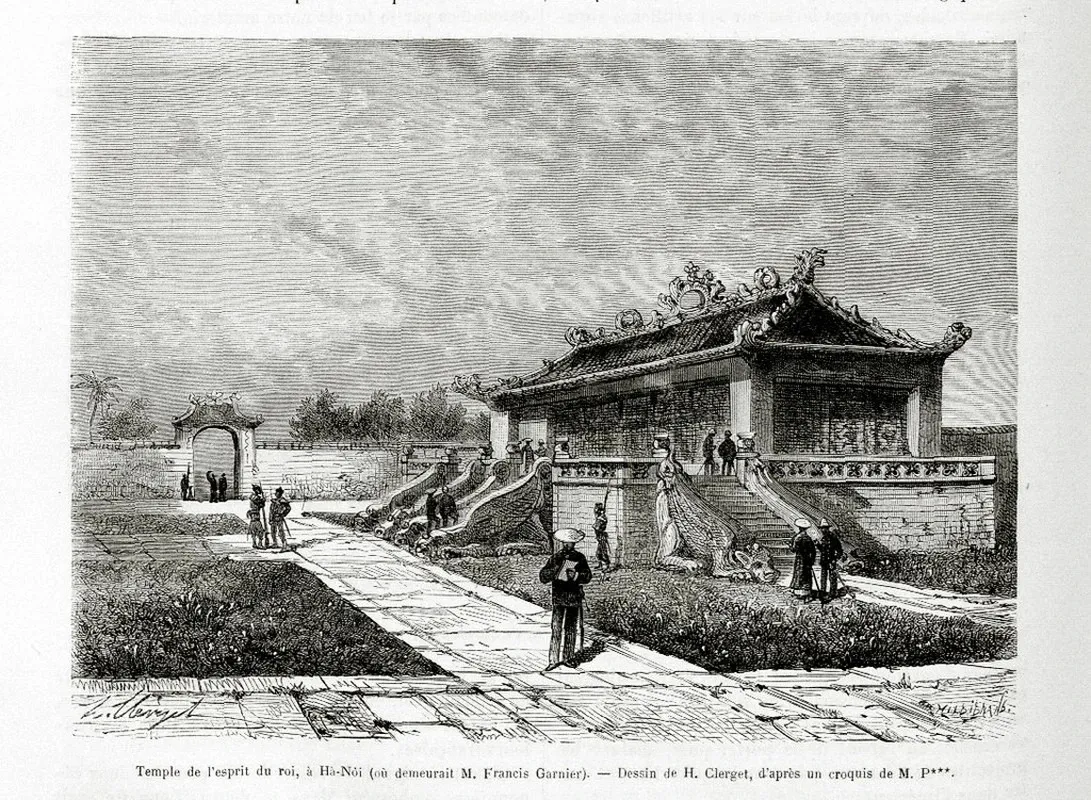
Kinh Thien Palace, the central relic of the Thang Long Imperial Citadel within the Thang Long Imperial Citadel complex. Image: Archive
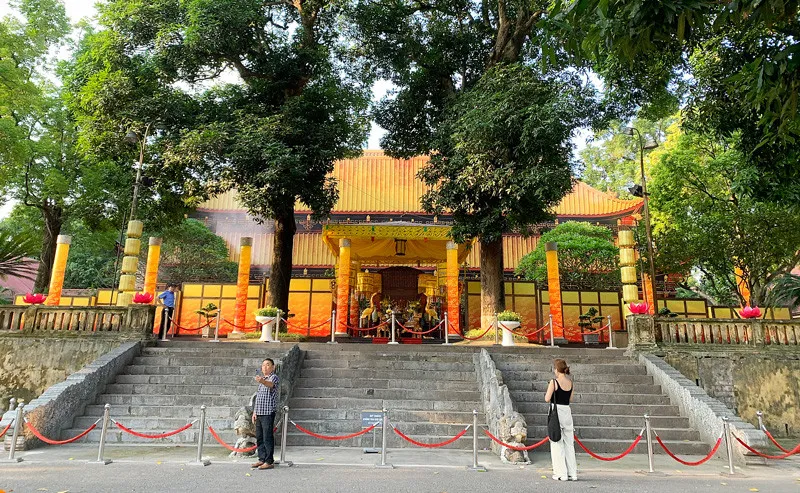
The current state of Kinh Thien Palace, being studied and restored to preserve its historical value. Image: Archive
Directions to Kinh Thien Palace
The Thang Long Imperial Citadel, where Kinh Thien Palace is located, is right in the center of Hanoi, making it easy for visitors to get here by various means of transport.
Private transport: Motorbikes or cars are flexible options. From the city center, you can go in the direction of Cat Linh Street, through Ton Duc Thang and Nguyen Thai Hoc streets, then turn left onto Hoang Dieu Street. Go straight for about 850m, and you will arrive at the gate of the Thang Long Imperial Citadel and Kinh Thien Palace.
Public transport: Buses are an economical and convenient choice. Many bus routes stop near the Thang Long Imperial Citadel, such as routes 02, 09, 22A, 33, 45, E02, etc. You can look up routes and stops that are suitable for your location.
Taxis, ride-hailing services: Taxi and ride-hailing services are always available, especially if you want to travel quickly and comfortably. Just book a car via an app or call the switchboard, and you will be taken directly to your destination.
The 600-Year History of Kinh Thien Palace Through Ups and Downs
Kinh Thien Palace carries a historical story spanning six centuries. According to Dai Viet Su Ky Toan Thu (Complete History of Dai Viet), the palace was built from 1428 during the reign of King Le Thai To and completed in 1465 during the reign of King Le Thanh Tong. The structure was built on Nung Mountain, the former site of the Can Nguyen and Thien An palaces from the Ly Thai To dynasty, demonstrating the continuity and continuous development of the Thang Long capital.
Although the Thang Long Imperial Citadel underwent many changes under the Quang Trung and Nguyen dynasties, Kinh Thien Palace was still preserved and restored. During the Nguyen dynasty, the palace became an important royal retreat whenever the king made a Northern tour or received ambassadors, demonstrating its irreplaceable role in the palace system.
The biggest upheaval for Kinh Thien Palace came in the late 19th century when the French colonialists destroyed the structure and built an artillery headquarters, named Long Tri (Dragon Pond). This name originated from the fact that there were stone dragons flanking the front and back of the structure. After 1954, this place became the headquarters of the Ministry of National Defence.
In 2004, the Ministry of National Defence handed over a part of the central area of the Thang Long Ancient Citadel to the Hanoi People’s Committee. Since then, the relic has been preserved, studied, and gradually restored, opening to visitors, helping future generations have the opportunity to admire and better understand the heroic history of the nation.
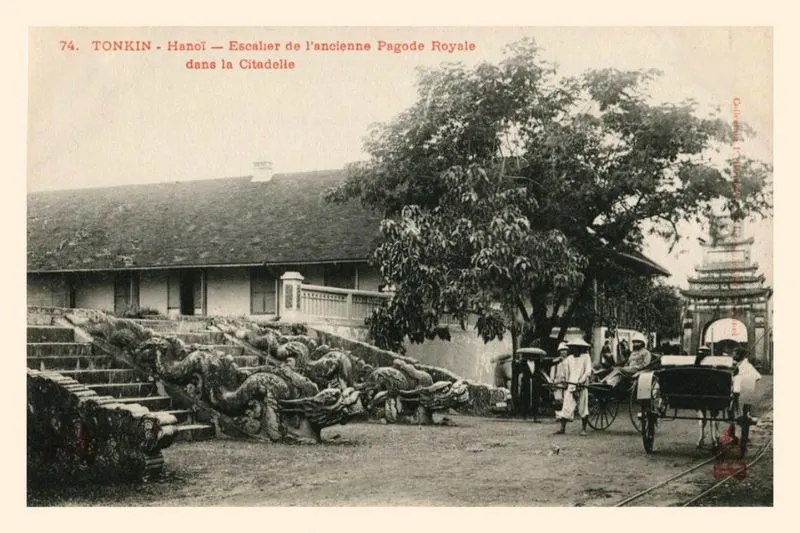
Kinh Thien Palace in the past, archive image recording historical marks. Image: Archive
Unique Architecture of Kinh Thien Palace During the Le Dynasty
Kinh Thien Palace Foundation
Kinh Thien Palace is not just a single architectural work but the center of the entire Hanoi Ancient Citadel relic complex. The location of the palace is clearly defined in the overall layout: in front are Doan Mon Gate and Hanoi Flag Tower, behind are Hau Lau (Princess’s Palace) and Bac Mon Gate, and on the East and West sides are enclosing walls. Today, visitors can still imagine the grandeur of this area through the Doan Mon Gate and Hau Lau that still exist.
The remaining foundation of the palace to this day is 57m long, 41.5m wide, and 2.3m high. The system of green stone steps with three entrances and railings over 100cm high on the south side still retains its majestic appearance.
Images from the late 19th century show that Kinh Thien Palace had unique wooden architecture, consisting of two Nhi-shaped houses, built in the style of overlapping roofs with two stories and eight roofs, with curved and pointed roof corners. On the roof, there was a decoration of a pair of dragons flanking the sun. Surrounding the palace was a large courtyard, with railings surrounding all four sides, creating a solemn and magnificent space.
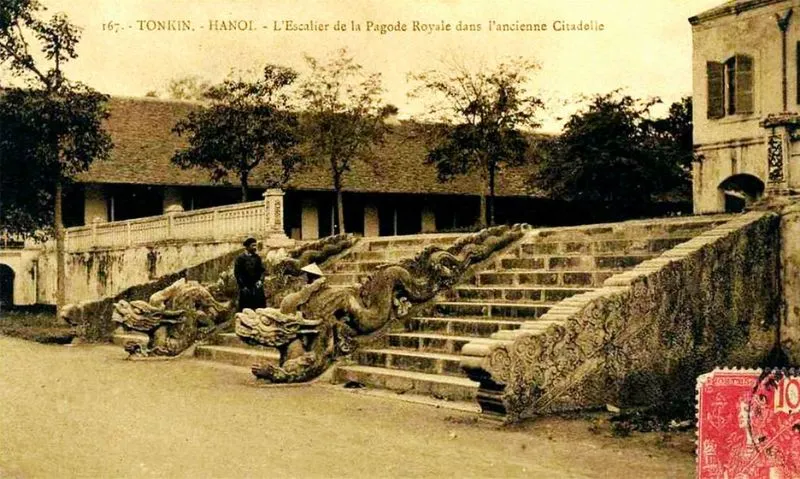
The foundation of Kinh Thien Palace in the past, a restored image helps visualize the ancient architecture. Image: Archive
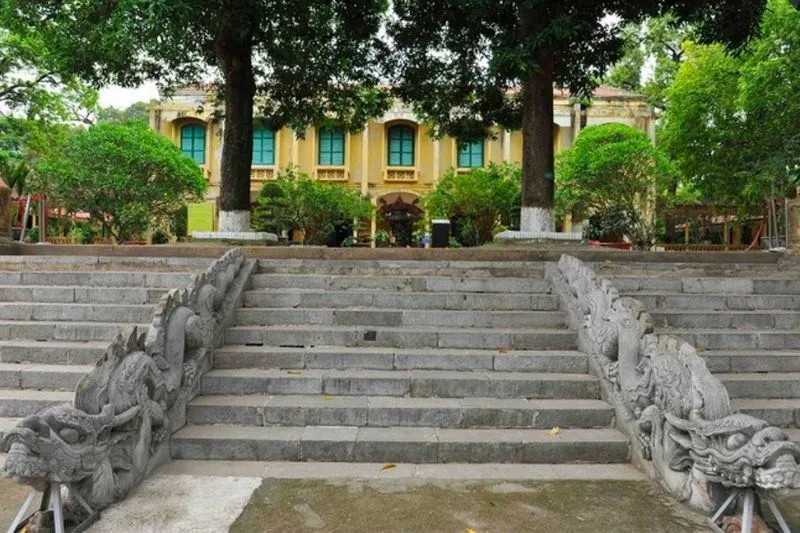
The current foundation of Kinh Thien Palace, the remaining traces of a great structure. Image: Archive

Although only the foundation remains, Kinh Thien Palace still evokes the grand scale of ancient palace architecture. Image: Archive
Majestic Dragon Steps
The dragon steps of Kinh Thien Palace are a masterpiece of stone sculpture, showing the sophistication and authority of Early Le dynasty art. The main dragon steps on the south side consist of ten steps, divided into three entrances by four large stone dragons. The structure measures 13.7m wide, 4.45m long, and 2.1m high. The pair of stone dragons carved in 1467 still retain their beauty almost intact to this day.
The stone dragons of Kinh Thien Palace are symbols of Early Le dynasty sculpture art with large dragon heads, round bulging eyes, long horns, and wavy manes. The soft dragon bodies undulate, tapering towards the palace foundation, with long fins on their backs rippling like flames and cloud patterns.
On the north side of the palace foundation, there is also a seven-step staircase with two other stone dragons, dating from the Le Trung Hung period (16th-18th centuries). The dragons here are 3.4m long, with bodies undulating in seven segments, with scales, backs like fish fins, and five-clawed feet. The railings are decorated with lotus flowers, waves, swords, flames, and cloud patterns, bearing the artistic style of this period.
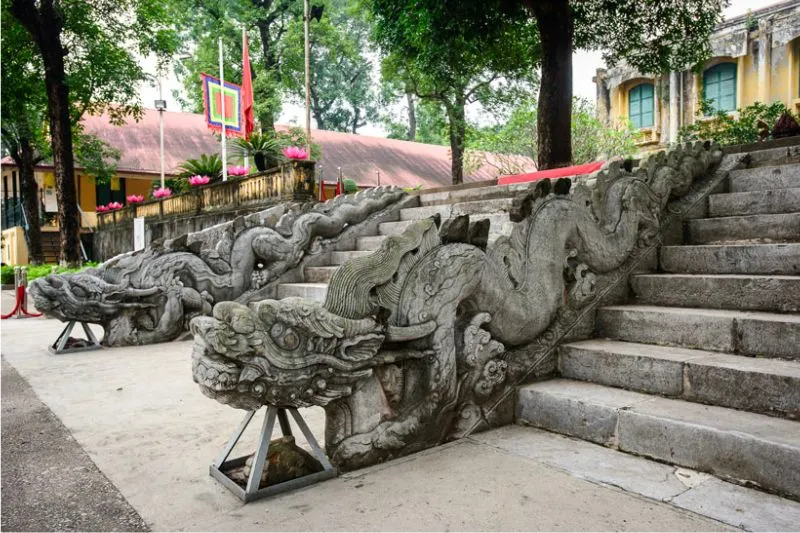
Stone dragon steps, a remaining architectural part of Kinh Thien Palace with great artistic value. Image: Archive

Stone dragons of the Early Le dynasty, symbols of sophisticated and majestic sculpture at Kinh Thien Palace. Image: Archive
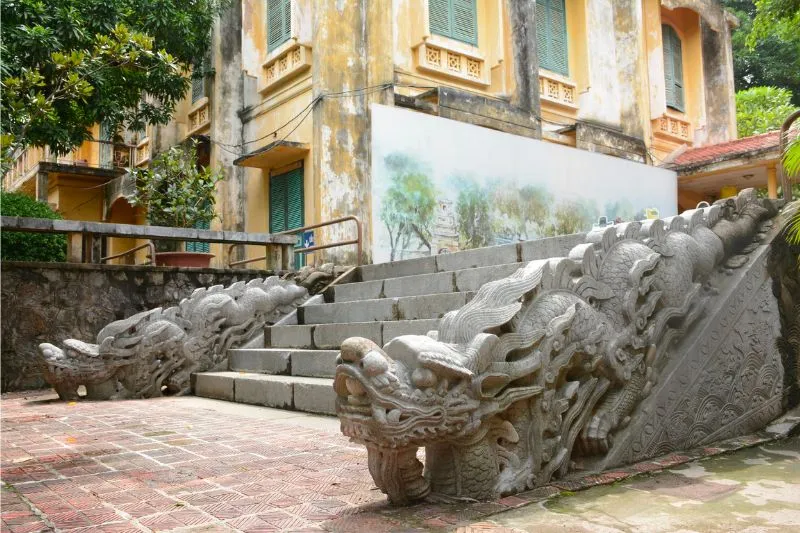
North dragon steps with the artistic style of the Le Trung Hung period. Image: Archive
Travel Experiences at Kinh Thien Palace and Thang Long Imperial Citadel
Visiting Kinh Thien Palace is an indispensable part of exploring the Thang Long Imperial Citadel. Although only the palace foundation and steps remain, the relic still offers visitors profound historical and cultural experiences.
Explore other relics in the Imperial Citadel: Besides Kinh Thien Palace, the Thang Long Imperial Citadel has many other attractive attractions such as Doan Mon Gate, Hau Lau, Hanoi Flag Tower, Dragon House, 18 Hoang Dieu archaeological site, etc. Each relic carries its own historical story, contributing to recreating a panoramic picture of the ancient Thang Long capital.
Suggested itinerary for visiting Kinh Thien Palace:
- Morning: Start your journey at Kinh Thien Palace, learn about the history, architecture, and cultural value of the relic. Then, visit other architectural works in the Imperial Citadel such as Doan Mon Gate, Hau Lau, Hanoi Flag Tower.
- Afternoon: Spend time exploring the 18 Hoang Dieu archaeological site to admire precious artifacts excavated from the Imperial Citadel’s soil. End your journey by strolling in the Imperial Citadel grounds, feeling the green and peaceful space here.
Useful travel tips:
- Ideal time to visit: Autumn (September – November) and spring (February – April) are the best times to travel to Hanoi and visit the Thang Long Imperial Citadel.
- Dress code: You should choose polite and discreet clothing when visiting historical and cultural relics.
- Tour guide: Hire a local tour guide to get detailed and in-depth information about the history and architecture of Kinh Thien Palace and the Thang Long Imperial Citadel.
- Combine visits: The Thang Long Imperial Citadel is located near many other famous tourist attractions in Hanoi such as the Temple of Literature – Quoc Tu Giam, Ho Chi Minh Mausoleum, Vietnam Museum of Fine Arts, etc. You can combine visiting these locations for a complete Hanoi exploration journey.
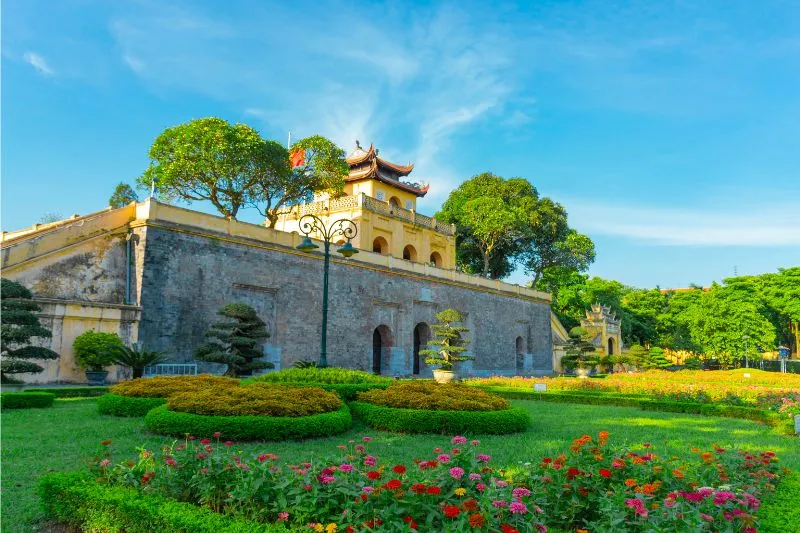
Exploring other relics in the Thang Long Imperial Citadel to better understand the history of the ancient capital. Image: Archive
Accommodation When Visiting Kinh Thien Palace
For convenient visits to Kinh Thien Palace and exploring Hanoi, you can choose hotels in the Ba Dinh or Hoan Kiem districts. Here are some suggestions:
- Romantique Hotel De Hanoi: 35-37 Bat Su Street, Hoan Kiem. Reference price from 540,000 VND/night.
- Hotel Bel Ami Hanoi: 244 Hang Bong Street, Hoan Kiem. Reference price from 194,000 VND/night.
- Grande Collection Hotel & Spa: 46-48 Bat Su Street, Hoan Kiem. Reference price from 402,000 VND/night.
- HANZ Hanoi Grand Maison Hotel: 108 Hang Bong Street, Hoan Kiem. Reference price from 185,000 VND/night.
- Bi Eco Suites Hanoi: No. 2 Alley 34, Dien Bien Phu Street, Ba Dinh. Reference price from 1,100,000 VND/night.
These hotels not only have convenient locations but also provide quality services, helping you have a comfortable and memorable vacation in Hanoi.
Conclusion
Kinh Thien Palace, although only ruins remain, is still a meaningful tourist destination in the heart of the Thang Long Imperial Citadel. A trip to Kinh Thien Palace is not just about admiring the traces of ancient architecture but also an opportunity to learn about the history, culture, and art of Vietnam during the Early Le dynasty. Come and feel the solemn historical space, so that each step is a page of history unfolding, helping you to love and be proud of the cultural heritage of the nation even more.